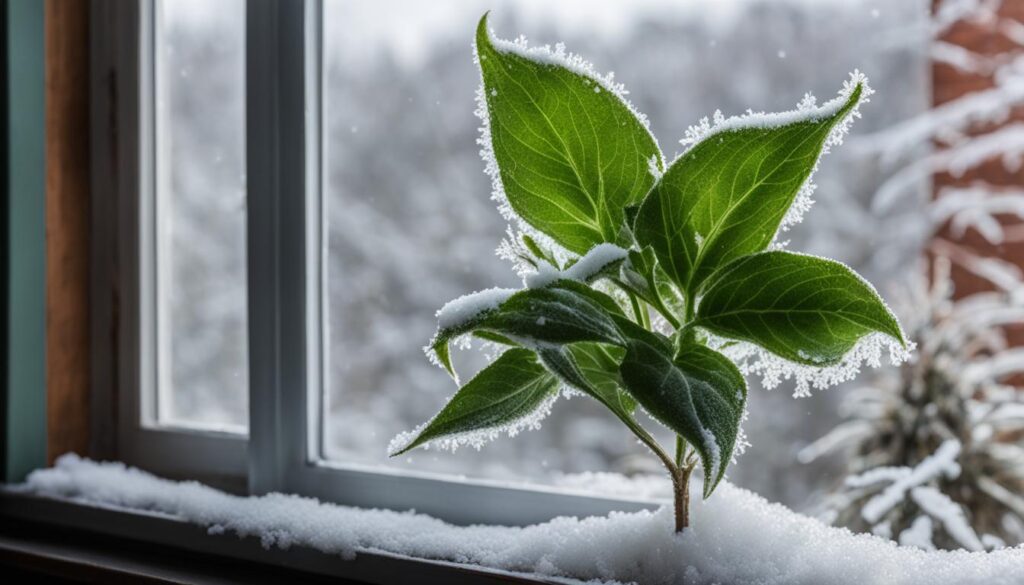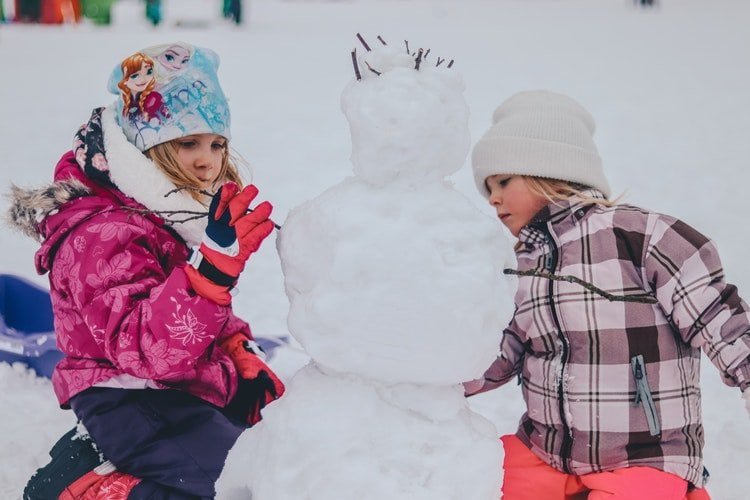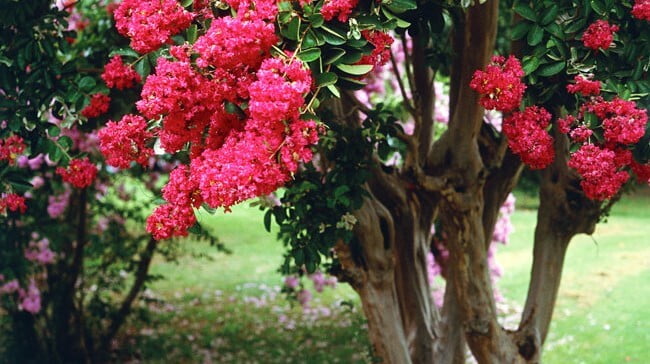Winter can be a challenging time for gardeners, especially in regions with cold temperatures and snow. However, with the right techniques and strategies, it is possible to continue growing plants indoors during the winter months. By bringing in heat-loving plants, utilizing structures like cold frames and hoop houses, and providing adequate light and care, US gardeners can enjoy the benefits of home gardening even in the chilly winter season.
Key Takeaways:
- Growing plants indoors during winter is possible with the right techniques and strategies.
- Bring in heat-loving plants and utilize structures like cold frames and hoop houses.
- Provide adequate light and care to ensure the growth and health of your plants.
- Choose plants that can tolerate lower light levels and temperature fluctuations.
- Inspect plants for pests and diseases before bringing them indoors and treat accordingly.
Choosing the Right Plants for Indoors During Winter
When it comes to indoor gardening during winter, selecting the right plants is key to success. Not all plants can thrive in the lower light levels and temperature fluctuations that come with the season. However, with a little research and careful consideration, you can find a variety of winter plants that are suitable for growing indoors.
Hardy Indoor Plants
If you’re looking for plants that can withstand the challenges of winter, consider hardy indoor plants. Geraniums, begonias, and succulents are excellent choices. These plants are known for their ability to tolerate lower light conditions and require less maintenance compared to other varieties. Plus, their vibrant colors and interesting foliage can add a touch of beauty to your indoor space.
Tropical Plants
If you’re longing for a taste of the tropics during the winter months, you can bring in tropical plants that thrive indoors. Plants like hibiscus and ferns can add a lush, tropical feel to your home. However, keep in mind that tropical plants may need a bit more care and attention. They require higher humidity levels and may benefit from regular misting or using a humidifier.
Plants for Low Light
If your indoor space has limited natural light, don’t worry. There are plenty of plants that can thrive in low light conditions. Snake plants, pothos, and philodendrons are all great choices for areas with minimal sunlight. These plants are not only low maintenance but also excellent air purifiers, helping to improve the air quality in your home.
A well-chosen selection of winter plants can make a big difference in the success of your indoor garden during the colder months. Whether you opt for hardy indoor plants, tropical varieties, or low light-loving plants, there are options to suit every preference and space. Just remember to provide them with the care they need, including proper watering, light, and temperature control. With the right plants and a little TLC, you can enjoy the beauty of nature even when it’s freezing outside.
Creating the Right Growing Environment Indoors
When it comes to indoor winter gardening, creating the right growing environment is crucial for the health and success of your plants. With the proper care and attention, you can provide them with the conditions they need to thrive even during the chilly months. Here are some essential tips to help you create the ideal indoor growing environment:
Providing Adequate Light
Light is one of the most important factors for indoor plants, especially during winter when natural light may be limited. To ensure your plants receive enough light, consider placing them near south-facing windows where they can get direct sunlight. If sunlight is scarce, you can supplement it with artificial grow lights. LED grow lights are energy-efficient and can provide the right spectrum of light for optimal plant growth. Remember to adjust the light duration according to your plants’ specific needs.
Temperature Control
Maintaining proper temperature levels is essential for your indoor plants’ well-being. Most indoor plants prefer temperatures between 65-75°F (18-24°C). Avoid placing them near drafty windows or heat sources like radiators, as sudden temperature fluctuations can stress your plants. Use a thermometer to monitor the temperature in the room and make any necessary adjustments to keep it within the optimal range.
Watering Indoor Plants
Watering indoor plants correctly is crucial, especially during winter when they may require less water due to reduced growth. Before watering, check the moisture level of the soil by inserting your finger about an inch deep. If it feels dry, it’s time to water your plant. Be careful not to overwater, as this can lead to root rot. Allow the soil to dry out slightly between waterings, and always use room temperature water to avoid shocking your plants. Additionally, misting the leaves with water can help increase humidity levels around your plants, which is beneficial, especially during the dry winter months.
By providing adequate light, maintaining proper temperature levels, and watering your indoor plants correctly, you can create the ideal growing environment for them to thrive during the winter season. Remember to monitor your plants closely, adjusting care as needed, and enjoy the beauty of gardening even during the coldest months.
Protecting Plants from Pests and Diseases
When bringing your plants indoors during the winter, it’s important to be vigilant in protecting them from pests and diseases. The controlled environment of your home can increase the risk of infestations and the spread of plant diseases. To ensure the health and well-being of your indoor plants, follow these tips for pest control and disease prevention:
1. Inspect and Treat:
Before bringing plants inside, carefully inspect them for pests or signs of diseases. Look for any visible insects, webs, or spots on the leaves. If you notice any issues, treat the plants accordingly before bringing them indoors. Washing plants with a gentle spray of water can help remove pests like aphids or spider mites. For more challenging infestations, consider using organic pesticides such as insecticidal soap or neem oil. These natural options can effectively control pests while being safe for your plants.
2. Practice Good Plant Hygiene:
Preventing the onset of diseases in indoor plants starts with practicing good plant hygiene. Avoid overwatering your plants, as excess moisture can create a breeding ground for fungal diseases. Ensure proper drainage by using pots with drainage holes and providing a well-draining potting mix. Additionally, proper air circulation is essential to prevent diseases. Avoid crowding your plants together and ensure they have enough space to breathe.
3. Quarantine New Plants:
When introducing new plants to your indoor garden, it’s important to quarantine them first. This precautionary measure helps prevent the spread of pests or diseases to your existing houseplants. Keep new plants separate from your other plants for a few weeks and monitor them closely for any signs of pests or diseases. If issues arise, treat the affected plants promptly to prevent further infestation.
By following these pest control and disease prevention practices, you can help protect your indoor plants and ensure they thrive throughout the winter season. Remember to monitor your plants regularly and address any issues promptly to maintain a healthy and vibrant indoor garden.
Are the Winter Edition tips for growing plants indoors applicable to container gardening as well?
Yes, the Winter Edition tips for growing plants indoors are very much applicable to container gardening as well. The comprehensive guide to container gardening indoors covers all the fundamental principles and techniques that can be applied to both indoor plant care and container gardening practices.
Conclusion
Indoor gardening during winter brings you a host of benefits, allowing you to enjoy year-round gardening despite the cold temperatures. With the right techniques and strategies, you can nurture your plants and continue to experience the joy of gardening even in the coldest months.
Not only does indoor gardening provide you with fresh produce and greenery, but it also enhances the air quality inside your home. Having thriving plants indoors can help purify the air, making your living space healthier and more enjoyable.
By following the winter plant care tips discussed in this article, you can successfully create a favorable environment for your indoor plants. From providing adequate light and temperature control to implementing pest control measures, you have the tools to overcome the challenges of winter and ensure the well-being of your plants.
So, don’t let the winter blues keep you away from gardening. Embrace the opportunity to cultivate a beautiful indoor garden and reap the rewards of year-round gardening. With a bit of care and attention, your indoor plants will thrive and bring you joy throughout the winter months.
FAQ
Can all plants be grown indoors during winter?
Not all plants are suitable for growing indoors during winter. It’s important to choose plants that can tolerate lower light levels and temperature fluctuations.
What are some suitable plants for indoor winter gardening?
Hardy indoor plants such as geraniums, begonias, and succulents are excellent choices. Tropical plants like hibiscus and ferns can also be brought indoors for the winter but may require more care.
How can I provide adequate light for indoor plants during winter?
Placing plants near south-facing windows or using grow lights can help ensure they receive enough light, especially since natural light may be limited during the winter months.
What temperature and humidity levels are best for indoor plants during winter?
Most indoor plants prefer temperatures between 65-75°F (18-24°C) and moderate humidity levels.
How can I prevent pest infestations and diseases when bringing plants indoors?
Before bringing plants inside, it’s important to inspect them for pests or signs of diseases and treat them accordingly. Washing plants with a hose can help remove pests, while organic pesticides like insecticidal soap or neem oil can be used for pest control.
What are the benefits of growing plants indoors during winter?
Growing plants indoors during winter allows gardeners to continue their passion for gardening year-round, provides fresh produce and greenery, and enhances indoor air quality.











